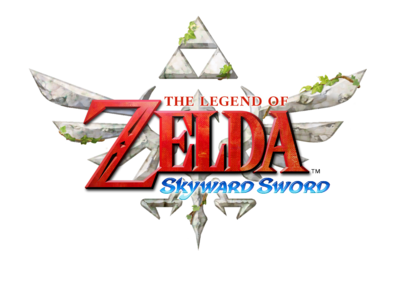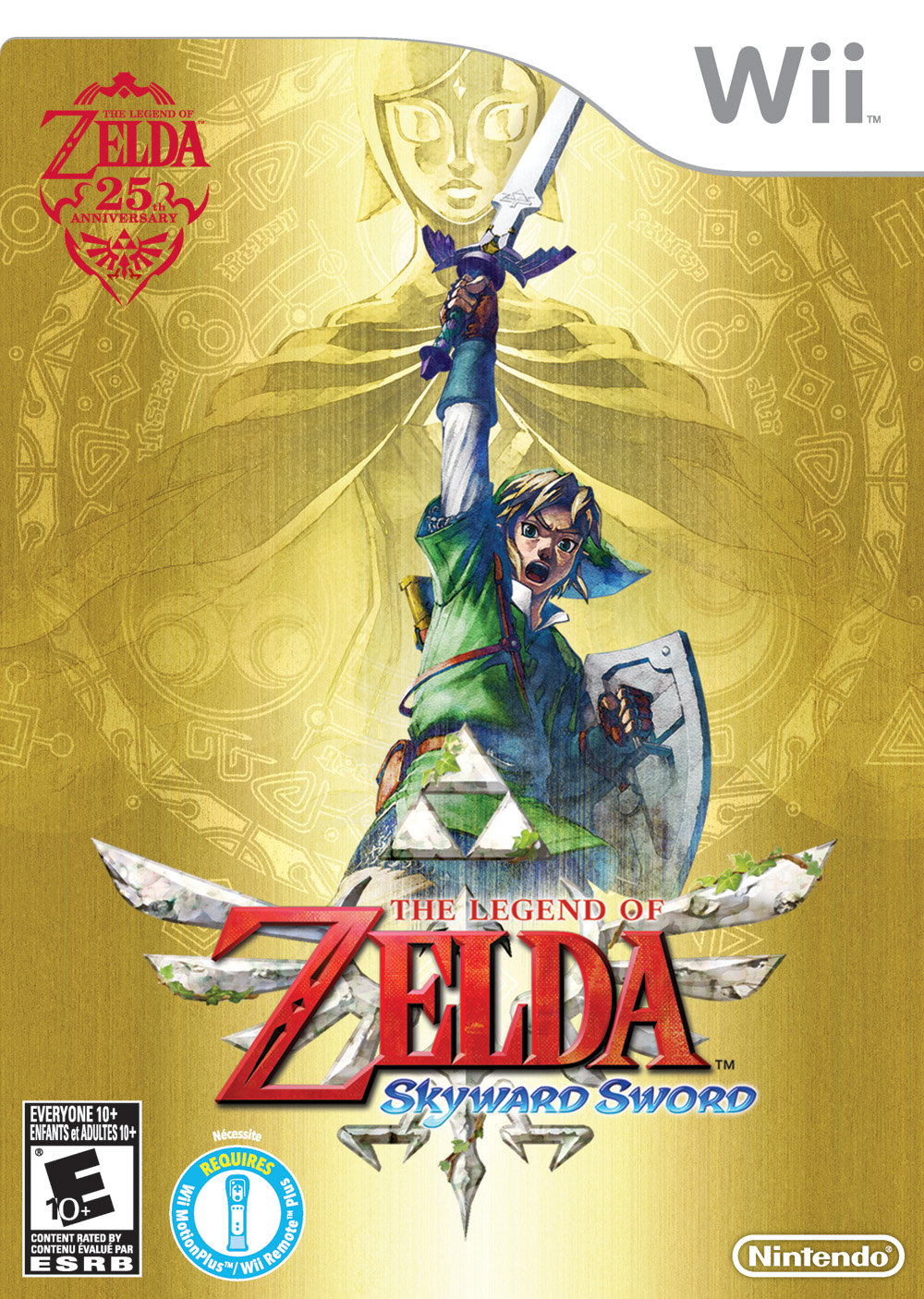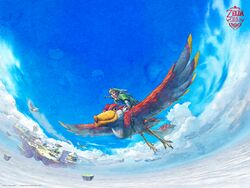The Legend of Zelda: Skyward Sword
| Release | ||
|---|---|---|
Platform | Date | |
Nintendo Wii U eShop | ||
🌎 July 16, 2021 | ||
| Credits | ||
Developer | ||
Producer | ||
Director | ||
| Guides | ||
Walkthrough | ||
| Media | ||
Gallery | ||

|
In-depth guide:
Skyward Sword Walkthrough |
The Legend of Zelda: Skyward Sword is the sixteenth installment in The Legend of Zelda series. The game is said to be the earliest in the Timeline as of now, taking place before Ocarina of Time. The game features the use of the Nintendo Wii MotionPlus to provide 1:1 motion controls, allowing players more accurate control to Link's Sword, items, and many other aspects of the game. The game was released worldwide throughout November 2011, with a special edition bundle being available in most regions that includes a Gold Wii Remote Plus bearing the Zelda symbol and a soundtrack containing a variety of orchestrated songs from The Legend of Zelda 25th Anniversary Symphony Concert. Skyward Sword is said to be the longest Zelda game in development.
In the February 17th, 2021 Nintendo Direct, a HD remake was announced for the Nintendo Switch for release on July 16th, 2021.
Story
- Main article: Skyward Sword Story
Long ago, the Goddess Hylia rescued her people from a great evil by sending them to the sky. Here, in Skyloft, they lived until the land below had been virtually forgotten, until the evil begins to resurface and plucks Zelda from the sky. Link, her childhood friend, must go down to the surface and prevent Lord Ghirahim from using her to fully revive his master. This story is a precursor to many elements in Ocarina of Time, such as the Master Sword.
Characters
The world of Skyward Sword features a vast array of both familiar and new faces from the series. The main characters that are featured include Link, Zelda (who is not of royalty this time around), and a new villain Demon Lord Ghirahim. Supporting characters have often been inspired by previous games often linking story elements with their new incarnations. There are a few character cameos from The Wind Waker, as well as Majora's Mask and Twilight Princess.
Races
Skyward Sword contains a significant amount of races, just like previous 3D games in the Zelda series. Some of the races (like the Gorons) are taken from earlier games, but there are a lot of new races too. An example of a new race would be the Kikwi race, the inhabitants of Faron Woods.
Here is a listing of all of the races found within The Legend of Zelda: Skyward Sword.
Enemies
Skyward Sword features many enemies from previous games, but most of their tactics are reworked to make them more challenging. Each foe requires a certain amount of strategy to beat, discouraging players from mindlessly slashing their way through a dungeon. The Wii Motion Plus device allows for precise enough motion detection to simulate 1:1 swordplay, and as a result the combat system is significantly different from the earlier games. Many enemies will block sword strikes from certain directions, and sometimes Link will have to strike in successive steps in order to beat an enemy.
Many of the enemy models are based on the enemies of A Link to the Past, like the similarities between the Bokoblins of Skyward Sword and the Moblins of A Link to the Past.
Bosses
The bosses of Skyward Sword follow a pattern similar to those seen in previous games of the franchise. Each main dungeon features a final boss, and most of the dungeons also feature one or more minibosses within and throughout the dungeons, before the final boss. The only exception is The Imprisoned, which is fought in between various missions, in a dedicated arena named "The Sealed Grounds".
Items
Skyward Sword features fewer items than previous games like Twilight Princess and Ocarina of Time, but most of them are upgradable and/or customizable in many ways. To upgrade an item, Link will have to gather a required amount of selected collectibles. These collectibles are sometimes dropped by monsters just like in The Wind Waker, but sometimes they can be found scattered about the world as for example hidden treasures.
Locations
The main world of Skyward Sword is based around the floating city of Skyloft, which acts as a central hub - in many ways similar to how Clock Town acts as a central hub in Majora's Mask. Skyloft is surrounded by a vast sky dotted with small floating islands. Beneath the clouds lies the overworld, a land that will become the kingdom of Hyrule in later installments of the series. The overworld is divided into three separate and disjoint parts, each with its own unique scenery.
Dungeons
Skyward Sword features a diverse set of seven dungeons, ranging from a temple in a sacred ground to an ancient facility and more.
Music
The Legend of Zelda: Skyward Sword is the first game in the franchise to feature an orchestrated soundtrack. Previously, Zelda games relied on MIDI and synthesizers that could only mimic the sound of true musical instruments. The arrangements feature a small traditional orchestra with strings, winds, brass, and percussion, but there are several pieces that include various folk and world instruments found in ethnomusicology. Both the Limited Edition Bundle and regular copy of the game include a 25th Anniversary Soundtrack CD featuring eight songs from the series performed in The Legend of Zelda 25th Anniversary Symphony Concert.
Development
- Main article: Skyward Sword Staff
Development began shortly after the release of Phantom Hourglass in 2007, though it didn't really take off until the team, including director Hidemaro Fujibayashi, returned from work on Spirit Tracks.[1] Early on, the developers wished to improve on Twilight Princess's cursory motion controls by providing a complete 1:1 experience.[citation needed] Encountering much difficulty, this idea was eventually scrapped in favor of focusing on more pressing issues of early development. Wii MotionPlus was picked back up when Eiji Aonuma saw its success in the newly released game Wii Sports Resort, and was successfully incorporated into the final product.[1]
Reception
Reviews for Skyward Sword tend to lean in a positive direction. Game Informer awarded Skyward sword a perfect 10/10.[2] Official Nintendo Magazine gave Skyward Sword a 98/100.[3] Edge magazine gave the game a perfect 10/10.[4] The game also received a 9.0 from Games TM[5] and a 93% from GamePro Germany.[6]
Other Media
- Penny Arcade Presents The Legend of Zelda: Skyward Sword is a five-part promotional web comic based on The Legend of Zelda: Skyward Sword. The comic was written and illustrated by Mike Krahulik and Jerry Holkins from Penny Arcade. It was published on the game's official website starting November 15, 2011 until December 13, 2011.
Gallery
- Main article: Gallery:Skyward Sword
Link on his Loftwing
Screenshots
- Main article: Category:Skyward Sword (Wii) Screenshot Files
Videos
Intro Trailer E3 2011
Gameplay Trailer E3 2011
GDC Trailer 2011
Comic Con Trailer 2011
Miyamoto Demo Trailer E3
Hands On Demo E3 2010
Iwata Asks: Skyward Sword Dev
Bill Trinen talks about Skyward Sword
Zelda Dungeon video walkthrough



























































































































































































